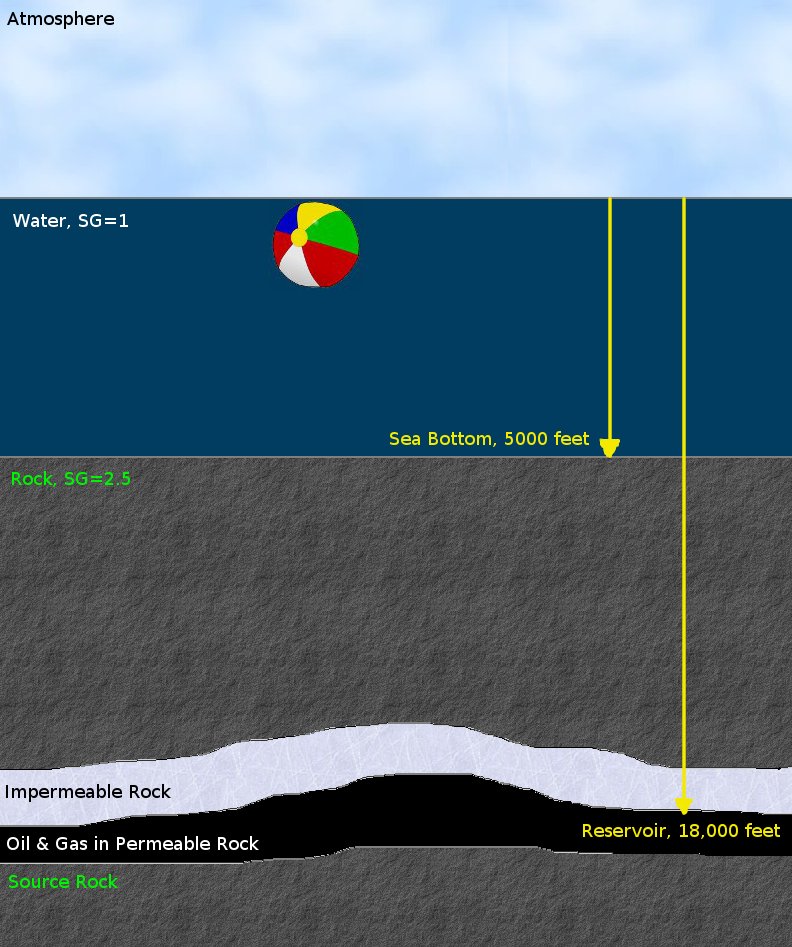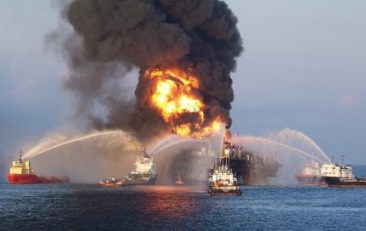The Macondo Prospect before the Deepwater Horizon floating oil rig arrived
The Macondo
Prospect is the name of the reservoir the
Deepwater Horizon floating oil rig was attempting to tap
when the blowout occurred. It holds an estimated 50
million barrels of recoverable oil plus significant
amounts of natural gas. The
reservoir is beneath 5,000 feet of water plus 13,000
feet of rock. These numbers are typical for the Gulf of Mexico.
The location is about 60 miles
South East of the mouth of the Mississippi river. It is 65% owned by BP
(British Petroleum.)
Oil is found only where certain, very specific,
conditions are met. You must have a source rock
containing organic material. The source rock must be
"cooked" to convert the organic material into oil.
The cooking temperature must be just right. If it is
too high, you get gas. If it is too low, no oil gets
formed. The oil, because it is lighter, rises until
it encounters impermeable rock, where the oil
collects in a reservoir. The reservoir is not a pool
of oil. The impermeable rock above the reservoir must
form a very good seal. Salt is a common seal. There
can be no cracks, even a small one, because even a
small leak will drain a large reservoir in a million
years. But cracks do occur and this explains natural
oil seeps. The source rock and the reservoir rock
must be permeable so that the oil can easily move
around.
The Macondo Prospect

Archimedes' Principle
 The beach ball (not to scale) is
threatening to bob up out of the water with a certain
force. The oil reservoir, like the beach ball, is also
trying to bob up. But the force is very roughly a
billion times greater.
The beach ball (not to scale) is
threatening to bob up out of the water with a certain
force. The oil reservoir, like the beach ball, is also
trying to bob up. But the force is very roughly a
billion times greater.
The first person to think clearly about these kind of
things (and publish) was Archimedes, in 250 B.C.
Google him. He is interesting. Archimedes' principle
states:
"a body fully or partially immersed in a fluid is
buoyed up by a force equal to the weight of the fluid
that body displaces."
The reservoir is the "body" and the "fluid" is the
water and rocks where the reservoir is found.
The Macondo Prospect reservoir is estimated to hold
50 million barrels of producible oil. The oil is
displacing rock, which has a specific gravity of
2.5 on average. That means rocks are 2.5 times
heavier for an equal volume of water. Therefore the
oil is "buoyed up" by the weight of 50 times 2.5, or
125 million barrels of water. But the oil has weight
which counter balances part of this. Oil typically has
a specific gravity of 0.85. So the weight of the oil
is equal to the weight of 0.85 times 50 or 42.5
million barrels of water. The difference is 82.5
million, which is a lot of buoyed uppedness. You
could also say the oil is trying to punch upward,
through the seal.
The oil industry often uses the units of
barrels, gallons, feet and pounds. Only one country in the
world uses these units, the United States. The reason
is tradition and perhaps insularity. It is a bizarre
system. Barrels for oil hold 42 gallons. Barrels for
water hold 55. Gallons come in two sizes. Miles have 5280 feet. It is hard to
think in English units--let alone do science in
English units. (Apologies for being a little off
point.)
